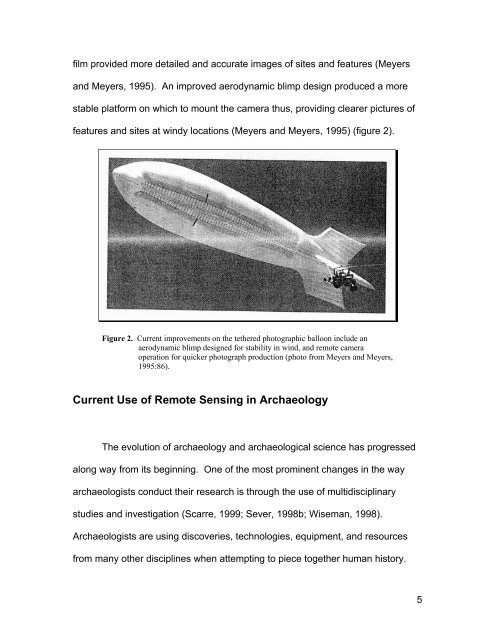A Review of Remote Sensing Application in Archaeological Research
A Review of Remote Sensing Application in Archaeological Research
A Review of Remote Sensing Application in Archaeological Research
Create successful ePaper yourself
Turn your PDF publications into a flip-book with our unique Google optimized e-Paper software.
film provided more detailed and accurate images <strong>of</strong> sites and features (Meyers<br />
and Meyers, 1995). An improved aerodynamic blimp design produced a more<br />
stable platform on which to mount the camera thus, provid<strong>in</strong>g clearer pictures <strong>of</strong><br />
features and sites at w<strong>in</strong>dy locations (Meyers and Meyers, 1995) (figure 2).<br />
Figure 2. Current improvements on the tethered photographic balloon <strong>in</strong>clude an<br />
aerodynamic blimp designed for stability <strong>in</strong> w<strong>in</strong>d, and remote camera<br />
operation for quicker photograph production (photo from Meyers and Meyers,<br />
1995:86).<br />
Current Use <strong>of</strong> <strong>Remote</strong> <strong>Sens<strong>in</strong>g</strong> <strong>in</strong> Archaeology<br />
The evolution <strong>of</strong> archaeology and archaeological science has progressed<br />
along way from its beg<strong>in</strong>n<strong>in</strong>g. One <strong>of</strong> the most prom<strong>in</strong>ent changes <strong>in</strong> the way<br />
archaeologists conduct their research is through the use <strong>of</strong> multidiscipl<strong>in</strong>ary<br />
studies and <strong>in</strong>vestigation (Scarre, 1999; Sever, 1998b; Wiseman, 1998).<br />
Archaeologists are us<strong>in</strong>g discoveries, technologies, equipment, and resources<br />
from many other discipl<strong>in</strong>es when attempt<strong>in</strong>g to piece together human history.<br />
5
















